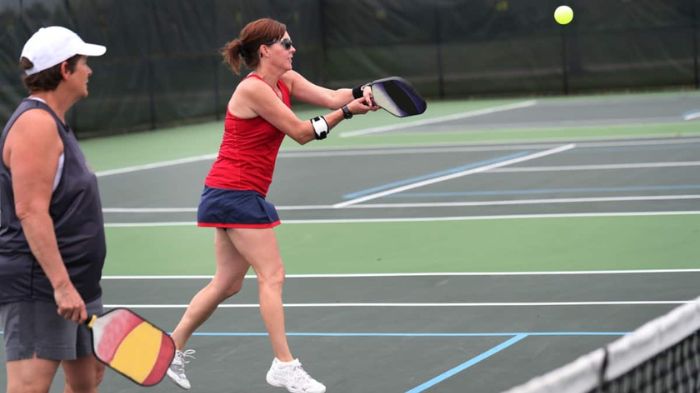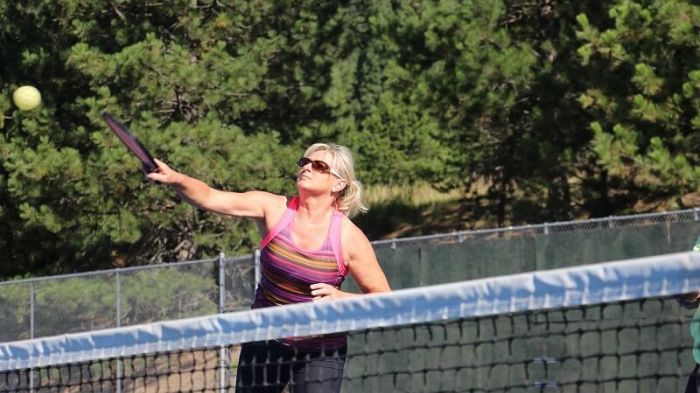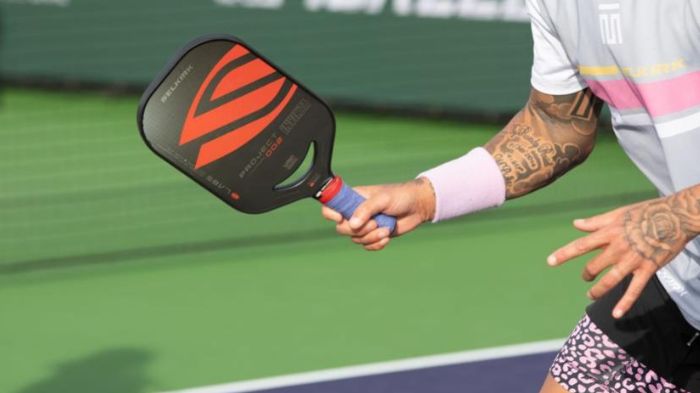Are you ready to elevate your pickleball game? If you’re wondering whether or not hitting overhand in pickleball is a valid option, the answer is yes! While many players stick to the traditional underhand and backhand strokes, adding an overhand stroke to your repertoire can give you a competitive edge.
Here, we’ll dive into everything you need to know about hitting and also will clear your doubt that can you hit overhand in pickleball – from when to use it, how to execute it properly, and even some tips on grips for maximum power. So grab your paddle and let’s get started!
The Three Main Strokes in Pickleball
Pickleball is an exciting and fast-paced game that requires different strokes to be successful. The three primary strokes in pickleball are the serve, the backhand, and the forehand.

Serve Up Some Power
The serve is one of the most crucial shots in pickleball because it initiates each point. It involves hitting the ball overhand from behind the baseline into your opponent’s service court. There are many types of serves you can use depending on your skill levels, such as a lob or spin serve.
Ace Your Backhand
The backhand shot is used when returning a ball hit to your non-dominant side. It requires quick reflexes and precise positioning to execute correctly. Players can choose between using a slice or topspin technique for their backhands.
Forehand Like a Pro
The forehand shot is the king of all pickleball strokes. It’s played with your dominant arm and involves striking balls hit to your strong side of the court. Forehand shots are played with your dominant arm and involve striking balls hit to your strong side of the court. They require good footwork and timing since they often come at high speeds
Ultimately, mastering these three main strokes will help players become more versatile on-court by giving them many options for how they approach any given play during a game of pickleball.
Get information on pickleball spike
The Overhand Stroke in Pickleball
- The overhand stroke in pickleball is one of the three main strokes used in the game, along with the forehand and backhand. While many players may feel more comfortable using their forehand or backhand, mastering the overhand stroke can give you a significant advantage on the court.
- When executed correctly, an overhand shot can be an incredibly powerful weapon in your arsenal. This type of shot allows you to hit down on the ball with greater force than either a forehand or backhand shot. Additionally, hitting overhead gives you greater reach and allows you to attack balls that are high above your head.
- However, hitting overhead does require some skill and practice. You need to have good footwork and positioning so that you can get into position to hit the ball cleanly. It’s also important to use proper technique when executing an overhead stroke so that you don’t injure yourself or lose control of the ball.
- While it may take some time to develop this skill set, adding an effective overhand shot to your game will make you a much more versatile player on the court!
When to Use an Overhand Stroke in Pickleball
- When done properly, picking an overhand stroke in pickleball can be helpful. The smash, or overhand stroke, is a strong and aggressive move that can surprise your opponents and help you score.
- When your opponent hits a high ball that gives you ample time to position yourself for the hit, using an overhand stroke could be advantageous. You can put additional force behind the ball and aim for a place that will be challenging for your opponent to return by taking an overhand shot.
- During a dink-shot pickleball rally is another circumstance in which adopting an overhand stroke could be advantageous. Taking an overhead swing could disrupt your opponent’s rhythm and potentially end the point on your terms if they are continuing to exchange gentle strokes with you in the non-volley zone (NVZ).
- There are disadvantages to this method, therefore it’s crucial not to rely on it excessively. Overhead shots are more difficult to execute consistently than other types of strokes because they demand good timing, coordination, and strength. Furthermore, they run the risk of being knocked into the net or out of bounds if not executed well or at the right moment.
- It takes practice and experience to know when to employ an overhead shot in pickleball. They have the potential to give players a competitive edge while competing at higher levels of difficulty when employed properly and successfully.
How to Execute an Overhand Stroke in Pickleball
Executing an overhand stroke in pickleball requires proper positioning and technique. Follow these steps to master this technique:

Step 1: Get into Position
Stand perpendicular to the net with your non-dominant foot forward and your dominant foot back. Hold your paddle in both hands at about waist height.
Step 2: Lift Your Paddle
As the ball approaches, use a slight upward motion with your non-dominant hand to lift the paddle up and behind you. At the same time, step forward with your dominant foot and transfer your weight onto that foot.
Step 3: Swing Forward and Hit the Ball
As you swing forward, extend your arm fully towards the ball while keeping a firm grip on the handle of the paddle. Make contact with the ball above shoulder height, using a downward motion similar to hitting a volleyball or tennis serve.
Step 4: Follow Through
Follow through by bringing your arm down and across your body towards the opposite hip. This will give you more power and control over where you hit the ball.
Step 5: Practice
Remember to keep practicing this stroke until it becomes second nature. With enough practice, hitting overhand shots can become one of your most effective weapons on the court.
Benefits and Drawbacks of Hitting Overhand in Pickleball
| Benefits of Hitting Overhand in Pickleball | Drawbacks of Hitting Overhand in Pickleball |
|---|---|
| Allows players to hit the ball at a steeper angle | Risk of injury, especially to the shoulder or elbow |
| Gives players greater control and power over the point | Overhand shots tend to be less accurate than other strokes |
| Increases the chances of winning points quickly and efficiently | Can make a player predictable and easier for opponents to anticipate |
| Provides players with more opportunities to change their strategy during a match | Overhand shots require a high level of skill to execute correctly |
| Enables players to generate more power than other strokes |
- As shown in the comparison table above, hitting overhand shots in pickleball has its benefits and drawbacks. On the one hand, overhand shots allow players to hit the ball at a steeper angle, giving them a better chance of winning points and taking control of the point.
- Further, overhand shots enable players to generate more power and create unpredictable angles and trajectories when combined with other shots like lobs or drops.
- On the other hand, the drawbacks of hitting overhand shots in pickleball include the risk of injury, especially to the shoulder or elbow if the proper form and technique are not used. Overhand shots also tend to be less accurate than other strokes, and relying too heavily on them can make a player predictable and easier for opponents to anticipate.
- Moreover, overhand shots require a high level of skill to execute correctly, which can be challenging for beginners.
- Therefore, players must weigh the benefits and drawbacks of hitting overhand shots in pickleball before deciding whether this type of shot is right for them.
- While hitting overhand shots can be an effective weapon on the court, it’s essential to practice with proper form and technique to reduce the risk of injury and avoid becoming predictable to opponents.
The Best Grips For Overhand Hits
If you’re serious about your pickleball game, you know that the perfect grip is just as important as nailing an overhand shot. A great grip can take your game to the next level, giving you more control and accuracy over your shots. But with so many different grips to choose from, where do you even start?

Fear not, fellow pickleball enthusiasts! We’re breaking down the three basic grips – the Continental, Eastern, and Western – and diving deep into the all-important Continental pickleball grip, the grip that can be used for every shot in pickleball. With this grip in your arsenal, you’ll be able to dominate the court with ease.
The Continental Pickleball Grip: Your Ticket to Overhand Shot Glory
Let’s start with the basics. When you shake hands with your paddle, you’re essentially using the Continental grip. It’s that simple! Once you’ve got your paddle comfortably in your hand to hit spike pickleball paddle, you’ll know you’ve got it right when you can see a V shape created by your thumb and index finger, with the V facing towards you. This is the neutral Continental grip, and it’s the one you’ll be using most often.
The neutral Continental grip is perfect for forehand and backhand dinking and backhand serve in pickleball driving the pickleball, as well as serving. But what about those overhand shots? Fear not, we’ve got you covered.
The Weak Continental Grip: Not So Helpful for Overhand Shots
The weak Continental grip is, well, weak. It won’t be much help to you when you’re attempting an overhand shot, but it’s great if you want to keep your paddle face open. With the V facing to the left, if you’re right-handed or to the right if you’re left-handed, it’s not a grip you’ll be using often.
The Strong Continental Grip: The Key to Aggressive Shots
Now we’re talking. The strong Continental grip is the one you want to use for aggressive shots, like the overhand hits with a lob shot and an overhead smash. This grip gives you more power and wrist action because your paddle, wrist, and arm are aligned. Just remember that this grip isn’t ideal when you’re close to the net.
To grip your paddle with a strong Continental grip, start with a neutral grip and then rotate it to the right if you’re right-handed or to the left if you’re left-handed. Adjust your grip slightly if it feels uncomfortable. With this grip, you’ll be hitting those overhand shots with ease.
Know more about Anna Leigh Waters a pro pickleball player
FAQs
Yes, hitting overhand shots in pickleball is allowed and can be very effective if executed correctly. The overhand stroke can help generate more power on your shots than just relying on underhand strokes alone. However, it’s important to use this shot selectively and only when necessary as it can also leave you vulnerable if not performed well.
One major benefit of using an overhand stroke in pickleball is that it allows for greater speed and power on your shots. It can also help mix up your gameplay and keep your opponents guessing. Additionally, using an overhead swing can give you more reach on high balls which may otherwise be difficult to return.
No, hitting a smash in pickleball is best executed when the ball is high or lobbed by your opponent, giving you ample time to set up and execute the shot. Attempting a smash from a low ball or while on the move can be challenging and risky, as it requires a lot of skill and accuracy to execute. It’s essential to identify the right moment to attempt a smash and be aware of the court’s positioning to avoid errors or losing the point.
Some basic rules of pickleball include serving underhand, allowing the ball to bounce once on each side before hitting it, and staying out of the non-volley zone (the area immediately surrounding the net) unless the ball bounces in that zone first. Other rules include calling the score before each serve, and only serving when the opposing team is ready.
Conclusion
Using an overhand hit in pickleball is a useful skill that can give you an advantage over your opponents. However, mastering this stroke requires practice, understanding when it’s appropriate to use, and executing it properly. You should also be aware of the limitations and drawbacks of this shot.
By incorporating the overhand stroke into your gameplay with consistent training and proper technique, you can elevate your performance on the court. So, give it a try and see how can you hit overhand in pickleball.x



